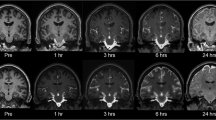Summary
Hexabrix (ioxaglate), a new low osmolality contrast agent, has been compared with Télébrix (ioxitalamate) in a series of 50 lumbar epidural venograms. The intensity of the pain and heat sensation experienced by the patient was significantly lower following the injection of Hexabrix. For this reason Hexabrix may be considered the contrast medium of choice for epidural venography. In 15 additional cases Hexabrix was compared with Amipaque (metrizamide) in the same iodine concentration (320 mg/ml). In these patients hardly any difference in pain and heat sensation was observed after the injection of both contrast agents. Frequently only a slight feeling of warmth was noticed. A minimal sensation of pain was occasionally observed to the same degree with both contrast agents.
Similar content being viewed by others
References
Almén, T., Boijsen, E., Lindell, S. E.: Metrizamide in angiography. I. Femoral angiography. Acta Radiol. [Diagn.] (Stockh.) 18, 33–38 (1977)
Almén, T.: Effects on venous vasomotion from the ionic content of contrast agent solutions. Acta Radiol. [Diagn.] (Stockh.) 17, 439–448 (1976)
Holm, M., Praestholm, J.: Ioxaglate, a new low osmolar contrast medium used in femoral angiography. Br. J. Radiol. 52, 169–172 (1979)
Meijenhorst, G. C. H.: Lumbar epidural double-catheter venography with metrizamide (Amipaque). Diagnostic Imaging 48, 244–252 (1979)
Meijenhorst, G. C. H.: Systematic double-catheter epidural venography in the diagnosis of lumbar disc herniation. Neuroradiology 16, 349–351 (1978)
Meijenhorst, G. C. H.: Epidurale Doppelkathetervenographie beim Bandscheibenprolaps; unbekannte Vene im Wirbelkanal. RÖFO 129, 581–587 (1978)
Meijenhorst, G. C. H.: Myelography and epidural doublecatheter venography. Br. Med. J. 1978/II, 205–206
Moreau, J. F.: Les nouveaux produits de contraste iodés. Med. Electro-Radiol. 146, 42–44 (1978)
Petitier, H., Crochet, D., Bizais, Y., Delumeau, J., de Laguerenne, J., le Douarin, L.: Etude des effects hémodynamiques d'un nouveau produit de contraste à structure dimère monacide. Ann. Radiol. 21, 297–300 (1978)
Sovak, M., Ranganathan, R., Lang, J. H., Lasser, E. C.: Concepts in design of improved intravascular contrast agents. Ann. Radiol. 21, 283–289 (1978)
Théron, J., Moret, J.: Spinal phlebography. Berlin, Heidelberg, New York: Springer 1978
Tillman, U., Adler, R., Fuchs, W. A.: Pain in peripheral arteriography — a comparison of a low osmolality contrast medium with a conventional compound. Br. J. Radiol. 52, 102–104 (1979)
Van Waes, P. F. G. M.: New low osmolality water-soluble contrast compounds in selective arteriography of the peripheral limbs. Diagnostic Imaging 48, 209–215 (1979)
Author information
Authors and Affiliations
Rights and permissions
About this article
Cite this article
Meijenhorst, G.C.H., de Bruin, J.N.T. Hexabrix (ioxaglate), a new low osmolality contrast agent for lumbar epidural double-catheter venography. Neuroradiology 20, 29–32 (1980). https://doi.org/10.1007/BF00346858
Received:
Issue Date:
DOI: https://doi.org/10.1007/BF00346858




